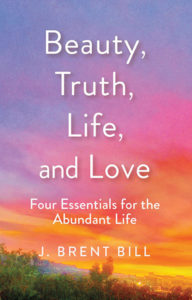Beauty, Truth, Life, and Love: Four Essentials for the Abundant Life
Reviewed by Rob Pierson.
April 1, 2020
 By J. Brent Bill. Paraclete Press, 2019. 144 pages. $16.99/paperback; $12.99/eBook.
By J. Brent Bill. Paraclete Press, 2019. 144 pages. $16.99/paperback; $12.99/eBook.
At the beginning of Beauty, Truth, Life, and Love, J. Brent Bill contrasts “an abundance life” with “an abundant life.” A life of abundance may include many good things like food, shelter, and time to read Friends Journal. It may also open the gates to a flood of excess that engulfs our garage and preoccupies our existence. In contrast, the gospels promise abundant life: causing us to become life-giving to ourselves, to radiate love, joy, and peace.
In several ways, this new publication adds on to Bill’s earlier book Sacred Compass. “Our sacred compass,” Bill wrote, “operates in our souls and calls us to life with God—life abundant and adventurous.” But where Sacred Compass focused on discernment—on finding one’s leading—this latest book takes note of markers along the way. I’d call them Bill’s personal testimonies of beauty, truth, life, and love.
Beauty is a rare bird, seldom sighted among Quaker testimonies. But Bill notes that the Creator God creates us to be inspired by creation: both by God’s and that of our fellow creatures. Although Bill acknowledges the early Quaker suspicion of the arts, he distinguishes between art as entertainment or distraction and the experiences of beauty that elicit life-giving responses of wonder and awe.
Truth expresses a more traditional testimony. Like a plumb line, truth tests whether our frame of life is out of whack and in danger of toppling. Bill urges us to avoid a fevered life driven by unexamined obligations, and instead live aligned within one’s self, even as one grows and changes over time.
Life might seem redundant as a marker for “abundant life,” but Bill points out that daily choices either suck the life out of us or give us the “vim, vigor, and vivacity” that enliven ourselves and those around us. Bill asks us to apply the old Quaker test to all that we do: Is there life in it?
Finally, love stands at the source of all the testimonies as the wellspring of action, but you might not know that from some versions of Faith and Practice. Love is a way of being, and Bill urges us to keep asking: Am I doing this out of love? or, in John Woolman’s language, is love the first motion?
How do we discriminate between accumulating a life of abundance and cultivating an abundant life? Follow the way of beauty, truth, life, and love, says Bill. If these four are not present in some task, relationship, or new opportunity, then pause and consider whether that path really leads toward life.
Both this book and Sacred Compass speak Bill’s Quaker experience in language intended for a wider Christian audience. Quotes from George Fox, Margaret Fell, William Penn, and naturalist John Burroughs mingle with Matthew, Mark, Luke, and John. The prophets hang out with Saint Augustine, Brother Lawrence, Wendell Berry, and occasionally Rumi or Hafiz.
On the surface, there’s nothing new here. Indeed, the many quotes point out that Bill is sharing from within a familiar stream of insights. However, the book offers an invitation to sit for a while and consider the role of beauty, truth, life, and love in one’s life choices. In each section, Bill interrupts the text with queries that take the form of meditations. From the section on beauty:
Relax your body, mind, and spirit.
Take two or three deep breaths.
Put the book down and think about the following slowly and gently.Does my place of worship encourage engagement with beauty? Could there be room for more beauty? What might my role be in helping that to happen?
For the rest of the writing, Bill adopts a folksy conversational manner, full of humor, particularly self-deprecating asides. That makes for an easy read. But at times I wondered whether the style was true to the plumb line of Bill’s text. There are so many quotes and queries that it’s difficult to discern what Bill himself has to say.
For me, Bill touches closest to the heart when he shares his own experience. For example, while talking about truth, Bill recalls framing his house. The plumb line becomes a physical reality. While talking about love, Bill takes us on the walk where he discovers his love for the place he calls home. At moments like these, we witness in tangible ways how beauty, truth, life, and love have come to signify God’s presence for Bill. And we pause to reflect how these four have been signposts on our own journeys as well.



Comments on Friendsjournal.org may be used in the Forum of the print magazine and may be edited for length and clarity.